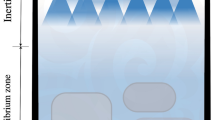Abstract
A computational investigation is performed to study the effects of injection velocity on the main dynamic parameters of the fuel cloud released into the open atmosphere. The volume, shape, and growth rate of the cloud, turbulence intensity, as well as the distribution of fuel concentration, temperature gradient, and self-ignition induction time are the most important parameters determining the mode of combustion that propagates through the cloud. A modified KIVA-based program is employed to fulfill the calculations. Systems of equations are solved by a finite-volume method. The k-ɛ model and discrete droplet model are applied for modeling gas-phase turbulence and liquid spray, respectively. The fuel-injection velocity is shown to have a major effect on turbulence intensity and uniformity of the cloud. With increasing injection velocity, the detonable part of the cloud rotates sooner and faster, and there is less time for ignition. A comparison with experimental results is performed for validation.
Similar content being viewed by others
REFERENCES
M. W. Glass, “Far-field dispersal modeling for fuel-air explosive devices,” Sandia National Laboratories Report No. SAND90-0528 (May 1990).
D. R. Gardner, “Near-field dispersal modeling for liquid fuel-air explosives,” Sandia National Laboratories Report No. SAND90-0686 (July 1990).
A. A. Amsden, P. J. O'Rourke, and T. D. Butler, “KIVA-II: a computer program for chemically reactive flows with sprays,” Los Alamos National Laboratory Report No. LA-11560-MS (May 1989).
G. M. Makhviladze, J. P. Roberts, and S. E. Yakush, “Combustion of two-phase hydrocarbon fuel clouds released into the atmosphere,” Combust. Flame, 118, 583–605 (1999).
W. A. Sirignano, Fluid Dynamics and Transport of Droplets and Sprays, Cambridge Univ. Press, UK (1999).
V. I. Alekseev, S. B. Dorofeev, V. P. Sidorov, and B. B. Chaivanov, “Experimental study of large scale unconfined fuel spray detonations,” Prog. Astronaut. Aeronaut., 154, 95–104 (1993).
A. Ungut and P. J. Shuff, “Deflagration to detonation transition from a venting pipe,” Combust. Sci. Technol., 63, 75–87 (1989).
A. M. Khokhlov, E. S. Oran, and G. O. Thomas, “Numerical simulation of deflagration to detonation transition: The role of shock-flame interactions in turbulent flames,” Combust. Flame, 111, 323–339 (1999).
I. O. Moen, “Transition to detonation in fuel-air explosive clouds,” J. Hazard. Mater., 33, 159–192 (1993).
Ya. B. Zel'dovich, V. B. Librovich, G. M. Makhviladze, and G. I. Sivashinsky, “On the development of detonation in a non-uniformly preheated gas,” Astronaut. Acta, 15, Nos. 5/6, 313–321 (1970).
A. N. Khokhlov, E. S. Oran, and J. C. Wheeler, “A theory of deflagration to detonation transition in unconfined flames,” Combust. Flame, 111, 323–339 (1999).
A. M. Bartenev and B. E. Gelfand, “Spontaneous initiation of detonations,” Prog. Energ Combust. Sci., 26, 29–55 (2000).
G. M. Makhviladze and D. I. Rogatykh, “Non-uniformities in initial temperature and concentration as a cause of explosive chemical reactions in combustible gases,” Combust. Flame, 87, 347–356 (1991).
W. B. Benedick, R. Knystautas, J. H. S. Lee, and S. R. Tieszen, “Detonation of unconfined large scale fuel spray-air clouds,” Prog. Astronaut. Aeronaut., 133, 297–310 (1991).
G. O. Thomas and A. Jones, “Some observations of the jet initiation of detonation,” Combust. Flame, 120, 392–398 (2000).
Y. Lizhong, F. Weicheng, Z. Xiaodong, and W. Qing'an, “Analysis of fire and explosion hazards of some hydrocarbon-air mixtures,” J. Hazardous Mater., A84, 123–131 (2001).
M. M. Doustdar, M. Hosseinalipour, and K. Mazaheri, “Numerical study of a two-phase unconfined fuel-air cloud characteristics to consider its detonability,” in: Proc. of the Tenth Annual Conf. of the CFD Society of Canada (2002), pp. 204–210.
M. M. Doustdar, K. Mazaheri, and M. Hosseinalipour, “Numerical study of ground effect on the detonability characteristics of unconfined two-phase clouds,” in: Proc. of 11th Annual Conf. of the CFD Society of Canada (2003), pp. 399–406.
J. C. Liu, S. S. Xue, G. S. Zhu, et al., “Experimental and numerical study of explosive dispersal and fuel-air cloud,” in: Proc. of the Colloquium on Gas, Vapor, Hybrid and Fuel-Air Explosions, Schaumburg, Illinois (1998), pp. 341–354.
A. A. Amsden, “KIVA-3: a KIVA Program with block-structured mesh for complex geometries,” Los Alamos National Laboratory Report No. LA-12503-MS (March 1993).
D. Bjerketvedt, J. R. Bakke, and K. V. Wingerden, “Gas explosion handbook,” J. Hazard. Mater., 52, 1–150 (1997).
A. E. Cote, Fire Protection Handbook, R. R. Donnelly and Sons, USA (2000), pp. 4.59–4.69
V. V. Koren'kov and A. S. Obukhov, “Effect of the location of the detonation initiation point and the position of the air-fuel cloud on explosion-field parameters,” Combust., Expl., Shock Waves, 37, No.6, 688–697 (2001).
C. R. Ferguson and A. T. Kirkpatrick, Internal Combustion Engines, John Wiley and Sons, New York (1999), pp. 256–259.
C. L. Yaws, Chemical Properties Handbook, McGraw-Hill, New York (1999), pp. 557–581.
T. A. Davletshina and N. P. Cheremisino., Fire and Explosion Hazards Handbook of Industrial Chemicals, Noyes Publ., USA (1998), pp. 180–183.
SAE Handbook, Vol. 3, Society of Automotive Engineers, USA (1992), pp. 23.54–23.64.
Author information
Authors and Affiliations
Additional information
__________
Translated from Fizika Goreniya i Vzryva, Vol. 41, No. 5, pp. 29–40, September–October, 2005.
Rights and permissions
About this article
Cite this article
Doustdar, M.M., Mazaheri, K. & Hosseinalipour, M. Computational Analysis of Injection-Velocity Effects on Dynamic Parameters of Unconfined Fuel-Vapor Clouds. Combust Explos Shock Waves 41, 510–520 (2005). https://doi.org/10.1007/s10573-005-0064-5
Received:
Revised:
Issue Date:
DOI: https://doi.org/10.1007/s10573-005-0064-5




